Potassium channel modulation by a toxin domain in matrix metalloprotease 23
- PMID: 19965868
- PMCID: PMC2838332
- DOI: 10.1074/jbc.M109.071266
Potassium channel modulation by a toxin domain in matrix metalloprotease 23
Abstract
Peptide toxins found in a wide array of venoms block K(+) channels, causing profound physiological and pathological effects. Here we describe the first functional K(+) channel-blocking toxin domain in a mammalian protein. MMP23 (matrix metalloprotease 23) contains a domain (MMP23(TxD)) that is evolutionarily related to peptide toxins from sea anemones. MMP23(TxD) shows close structural similarity to the sea anemone toxins BgK and ShK. Moreover, this domain blocks K(+) channels in the nanomolar to low micromolar range (Kv1.6 > Kv1.3 > Kv1.1 = Kv3.2 > Kv1.4, in decreasing order of potency) while sparing other K(+) channels (Kv1.2, Kv1.5, Kv1.7, and KCa3.1). Full-length MMP23 suppresses K(+) channels by co-localizing with and trapping MMP23(TxD)-sensitive channels in the ER. Our results provide clues to the structure and function of the vast family of proteins that contain domains related to sea anemone toxins. Evolutionary pressure to maintain a channel-modulatory function may contribute to the conservation of this domain throughout the plant and animal kingdoms.
Figures
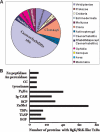
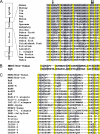

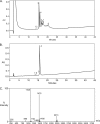
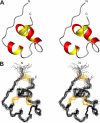
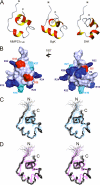
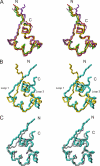
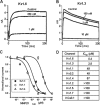
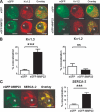
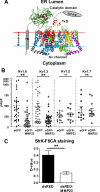
Similar articles
-
A potassium-channel toxin from the sea anemone Bunodosoma granulifera, an inhibitor for Kv1 channels. Revision of the amino acid sequence, disulfide-bridge assignment, chemical synthesis, and biological activity.Eur J Biochem. 1997 Feb 15;244(1):192-202. doi: 10.1111/j.1432-1033.1997.00192.x. Eur J Biochem. 1997. PMID: 9063464
-
Structural conservation of the pores of calcium-activated and voltage-gated potassium channels determined by a sea anemone toxin.J Biol Chem. 1999 Jul 30;274(31):21885-92. doi: 10.1074/jbc.274.31.21885. J Biol Chem. 1999. PMID: 10419508
-
Sea anemone peptides with a specific blocking activity against the fast inactivating potassium channel Kv3.4.J Biol Chem. 1998 Mar 20;273(12):6744-9. doi: 10.1074/jbc.273.12.6744. J Biol Chem. 1998. PMID: 9506974
-
Domain structure and function of matrix metalloprotease 23 (MMP23): role in potassium channel trafficking.Cell Mol Life Sci. 2014 Apr;71(7):1191-210. doi: 10.1007/s00018-013-1431-0. Epub 2013 Aug 3. Cell Mol Life Sci. 2014. PMID: 23912897 Free PMC article. Review.
-
Discovery and characterization of cnidarian peptide toxins that affect neuronal potassium ion channels.Toxicon. 2009 Dec 15;54(8):1119-24. doi: 10.1016/j.toxicon.2009.02.032. Epub 2009 Mar 6. Toxicon. 2009. PMID: 19269305 Review.
Cited by
-
The algal selenoproteomes.BMC Genomics. 2020 Oct 7;21(1):699. doi: 10.1186/s12864-020-07101-z. BMC Genomics. 2020. PMID: 33028229 Free PMC article.
-
A novel epileptic encephalopathy mutation in KCNB1 disrupts Kv2.1 ion selectivity, expression, and localization.J Gen Physiol. 2015 Nov;146(5):399-410. doi: 10.1085/jgp.201511444. J Gen Physiol. 2015. PMID: 26503721 Free PMC article.
-
Molecular characterization of porcine MMP19 and MMP23B genes and its association with immune traits.Int J Biol Sci. 2011;7(8):1101-13. doi: 10.7150/ijbs.7.1101. Epub 2011 Sep 14. Int J Biol Sci. 2011. PMID: 21927579 Free PMC article.
-
Matrix metalloproteinases as breast cancer drivers and therapeutic targets.Front Biosci (Landmark Ed). 2015 Jun 1;20(7):1144-63. doi: 10.2741/4364. Front Biosci (Landmark Ed). 2015. PMID: 25961550 Free PMC article. Review.
-
Helminth Immunomodulation in Autoimmune Disease.Front Immunol. 2017 Apr 24;8:453. doi: 10.3389/fimmu.2017.00453. eCollection 2017. Front Immunol. 2017. PMID: 28484453 Free PMC article. Review.
References
-
- Aiyar J., Withka J. M., Rizzi J. P., Singleton D. H., Andrews G. C., Lin W., Boyd J., Hanson D. C., Simon M., Dethlefs B., Gutman G. A., Chandy K. G. (1995) Neuron 15, 1169–1181 - PubMed
-
- MacKinnon R., Cohen S. L., Kuo A., Lee A., Chait B. T. (1998) Science 280, 106–109 - PubMed
-
- Ohno M., Menez R., Ogawa T., Danse J. M., Shimohigashi Y., Fromen C., Ducancel F., Zinn-Justin S., Le Du M. H., Boulain J. C., Tamiya T., Menez A. (1998) Prog. Nucleic Acids Res. Mol. Biol. 59, 307–364 - PubMed
-
- Cousin X., Bon S., Massoulié J., Bon C. (1998) J. Biol. Chem. 273, 9812–9820 - PubMed
Publication types
MeSH terms
Substances
Grants and funding
LinkOut - more resources
Full Text Sources
Other Literature Sources
Molecular Biology Databases

